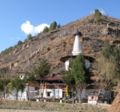Thangtong Gyalpo: Difference between revisions
No edit summary |
No edit summary |
||
| Line 1: | Line 1: | ||
[[File:Thangtong Gyalpo.png|frame|Thangtong Gyalpo]] | [[File:Thangtong Gyalpo.png|frame|Thangtong Gyalpo]] | ||
'''Thangtong Gyalpo''' ([[Wyl.]] ''thang stong rgyal po'') aka '''Tsöndrü Zangpo''' (Wyl. ''brtson 'grus bzang po'') (1385-1509) was a famous Tibetan [[siddha]] who travelled extensively in China, Tibet and other eastern countries, built numerous temples and metal bridges and founded monasteries at [[Dergé]] and elsewhere. | '''Thangtong Gyalpo''' ([[Wyl.]] ''thang stong rgyal po'') aka '''Tsöndrü Zangpo''' (Wyl. ''brtson 'grus bzang po'') (1385-1509) was a famous Tibetan [[siddha]] who travelled extensively in China, Tibet and other eastern countries, built numerous temples and metal bridges and founded monasteries at [[Dergé]] and elsewhere. | ||
He is said to be an emanation of the mind aspect of Guru Rinpoche. | |||
His name, Thangtong Gyalpo, means ''King of the Empty Plain''. While he was engaged in meditation in the Gyede Plain in Tsang, he had a vision of five dakinis, who approached him and sang verses of praise. One of the verses says: | |||
:On the great spreading plain | |||
:The yogin who understands emptiness | |||
:Sits like a fearless king | |||
:Thus we name him King of the Empty Plain. <ref>*From the Notes to the Translator’s Introduction to the ''Life of Shabkar'' </ref> | |||
==References== | |||
<small><references/></small> | |||
==Tibetan texts== | |||
Biography of Thangtong Gyalpo by Lochen Gyurme Dechen, ''grub pa’i dbang phyug chen po lcags zam pa thang thong rgyal po’i rnam thar ngo mtshar kun gsal nor bu’i me long gsar pa.'' Wood blocks of this biography have been carved at Thubten Chöling Monastery in Nepal under the inspiration of Dza [[Trulshik Rinpoche]]. | |||
==Further Reading== | ==Further Reading== | ||
Revision as of 09:47, 27 June 2011

Thangtong Gyalpo (Wyl. thang stong rgyal po) aka Tsöndrü Zangpo (Wyl. brtson 'grus bzang po) (1385-1509) was a famous Tibetan siddha who travelled extensively in China, Tibet and other eastern countries, built numerous temples and metal bridges and founded monasteries at Dergé and elsewhere.
He is said to be an emanation of the mind aspect of Guru Rinpoche.
His name, Thangtong Gyalpo, means King of the Empty Plain. While he was engaged in meditation in the Gyede Plain in Tsang, he had a vision of five dakinis, who approached him and sang verses of praise. One of the verses says:
- On the great spreading plain
- The yogin who understands emptiness
- Sits like a fearless king
- Thus we name him King of the Empty Plain. [1]
References
- ↑ *From the Notes to the Translator’s Introduction to the Life of Shabkar
Tibetan texts
Biography of Thangtong Gyalpo by Lochen Gyurme Dechen, grub pa’i dbang phyug chen po lcags zam pa thang thong rgyal po’i rnam thar ngo mtshar kun gsal nor bu’i me long gsar pa. Wood blocks of this biography have been carved at Thubten Chöling Monastery in Nepal under the inspiration of Dza Trulshik Rinpoche.
Further Reading
- Cyrus Stearns, King of the Empty Plain: The Tibetan Iron-Bridge Builder Tangtong Gyalpo, Snow Lion, 2007
- Manfred Gerner, Chakzampa Thangtong Gyalpo - Architect, Philosopher and Iron Chain Bridge Builder, 2007 (available online here)
- Tashi Tsering, 'On the Dates of Thang stong rgyal po' in Ramon N. Prats ed. The Pandita and the Siddha: Tibetan Studies in Honour of E. Gene Smith, New Delhi: Amnye Machen, 2007
Internal Links
External Links
Gallery
-
Dungtse Lhakhang, a temple in form of a chörten near Paro in Bhutan was built by Thangtong Gyalpo. The roof construction is made of iron.
